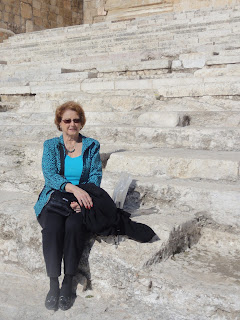Jerusalem - The City of David
Jerusalem
The Holy City
The City of the Prophets
City of Peace
Jerusalem, the blessed city with a hundred names, is the only city in
the world considered sacred by Jews, Christians and Muslims.
In his final days, Jesus stayed in Jerusalem and the villages surrounding it.
He prayed on the Mount of Olives and taught in the Temple. He spoke to the
masses who gathered to acclaim him the long-awaited Messiah. On the
cobblestone streets of Jerusalem, Jesus walked his last steps. Here he was crucified.
From the Mount of Olives, Jesus ascended into heaven
with the promise that he would come again.
Jesus experienced Jerusalem in all its glory. It was a beautiful, fortified city
surrounded by walls. The second temple still stood in its majesty. To the Jews,
Jerusalem symbolizes their past and represents their hopes for the future.
The City of David, the matrix of the city of Jerusalem, has been inhabited continuously
since the time of King David. David established Jerusalem as the capital and worship center
of the God of Israel. Later he built an altar on what became the Temple Mount.
In this area, archaeologists have uncovered interesting artifacts from the
time of the City of David and from the Kings of Judah.
The Babylonian destruction of Jerusalem in 586 BC is also evidenced in the excavation.
The layers of ashes and destroyed buildings found here corroborates Nehemiah's description of
the ruins in the City of David as he found them more than 140 years later. (Nehemiah 2:11-17)
I was fascinated by the discoveries and loved walking in the middle of history!
One of the most impressive findings was the water supply system built for the city by ancient engineers. They created systems which brought water from the Gihon Springs (located outside of the city) to inside the walls using shafts and tunnels. Warren's Shaft is the oldest supply system in Jerusalem and we climbed right to the bottom!
I also enjoyed seeing Hezekiah's tunnel. It was dug during the reign of King Hezekiah (about 700 BC) and transported water from the Gihon Spring to a reservoir, the Pool of Siloam.
The Pool lay inside the city walls to protect the water supply from enemies. (2 Chronicles 32:30)
The tunnels where we walked were narrow, winding, dark and musty.
We walked through pools of water, on sandbags, under low ceilings and traveled up
and down many flights of stairs. The tunnels are 533 meters (1748 feet) in length.
The Pool of Siloam (above) is known from the New Testament story where Jesus healed
the blind man by spitting on the ground, making mud and placing it on his eyes.
Jesus then sent the man to wash in the Pool of Siloam.
Our next stop was to explore the Jerusalem Archaeological Park. This seemed to be ironically named since much of Jerusalem appeared to be a large excavation site. :) The park researches and displays layers of discoveries made in Jerusalem's Old City, from many different periods The park encompasses the area around the Temple Mount all the way up to the slopes of the Mount of Olives.
This site was a historical gold mine for Israeli archaeologists in the 1970's and 80's.
Interesting Byzantine and early Arab structures were found, but the most dramatic finds were
from the Herodian period, the late 1st century B.C. King Herod the Great rebuilt the Second
Temple on the exact site of its predecessor, where the Dome of the Rock now stands.
In the middle of the photo above, you can see the white pavement of an impressive
main street and commercial area from the Second Temple period.
The protrusion in the middle of the wall is known as Robinson's Arch. Named for a 19th century explorer, it is a remnant of a monumental bridge to the Temple Mount, reached by ancient steps which were also uncovered. The square cut stones heaped at the end of the street came from the top of the original wall, evidence of the Roman destruction of 70 A.D.
The stones had precision-cut borders and miraculously held together by their sheer size and weight, not by mortar. The archaeologists differentiated the original stones from the newer ones so that we could see clearly the contrasts, yet preserve the historical character of the sites.
The back of the Temple Mount can be seen as it rises high above the city.
Currently this building is a Muslim mosque.
The broad, impressive southern steps are mostly original and once brought hordes
of Jewish pilgrims up through the southern gates of the Temple Mount.
Mother rests on the uneven steps formed centuries ago.
The columns were uncovered and may have been near the ritual baths at the bottom of the stairs.
These baths were used for the purification rites once demanded of Jews before they
entered the sacred temple precincts.
We are just amazed at the things we are learning - and love how they constantly
confirm the passages we study in the Bible. What an adventure!























Comments